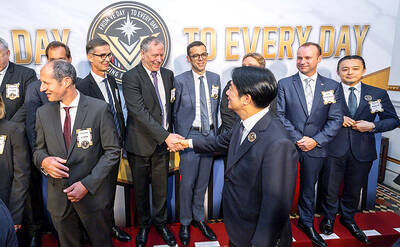Google and T-Mobile unveiled their answer to the iPhone on Tuesday, pulling the wraps off a slick mobile device that combines a touch screen and a keyboard and is designed to put the Internet in the pockets of millions of cellphone users.
The T-Mobile G1, which will be available in the US on Oct. 22, is the first mobile phone to be powered by Google’s Android operating system. It represents a milestone in Google’s efforts to extend its dominance of the PC-based Internet to mobile phones and further loosen the control that wireless carriers have over what consumers can do with their phones.
Analysts said that the G1 did not represent the kind of revolutionary change in design and function that Apple introduced last year with the iPhone. But the G1 is likely to further accelerate two trends that will have a lasting impact on the wireless industry — the growing use of the Internet on the go, and the ability of consumers to customize their phones with their favorite functions.

PHOTO: AP
“I am not sure people are going to be lining up at stores for this device,” said Rajeev Chand, an analyst with Rutberg & Co. “The iPhone was a game changer from a consumer perspective. The Google phone may be more of game changer from an industry perspective.”
The G1, which is made by Taiwanese electronics maker HTC (宏達電), has a large color touch screen that slides out to expose a full keyboard. It also has a 3-megapixel camera, GPS navigation, WiFi access and an Internet browser. It will sell for US$179, or US$20 less than the iPhone, with a two-year voice and data plan.
“This is as good a computer as you had a few years ago,” said Google’s co-founder Larry Page, who along with co-founder Sergey Brin arrived on rollerblades at the New York stage where Google and T-Mobile held a news conference to unveil the G1.
Although several applications, including Google’s search, maps, Gmail and YouTube, come installed on the phone, the G1 is also meant to encourage third-party developers to create programs to run on it. Like Apple, Google will include an applications store, called the Android Marketplace, where the owners of the G1 and future Android-powered phones will be able to download those programs.
Google said that developers would have virtually unfettered access to the marketplace, leaving it up to consumers — not Google or T-Mobile — to decide what they want to run on their phones.
While the G1 is expected to compete with high-end smartphones like the iPhone and the BlackBerry line of devices made by Research in Motion, Google’s aims are far different from those of its rivals.
Google makes the Android software available for free to carriers and handset makers who want to use it to power their own devices. Google hopes that many will choose to do so, populating the market with mobile phones that have easy access to Google’s services. Just like it does on the PC-based Internet, Google hopes to earn money from advertising.
T-Mobile, is counting on the G1 to increase its sale of data plans and said it believed the devices would appeal to consumers and business users.
“I think frankly this device will have mass appeal,” said Cole Brodman, chief technology and innovation officer of T-Mobile USA.
Android is unlikely to take the smartphone market by storm overnight. Despite its success, the iPhone accounted for just 2.8 percent of smartphones sold worldwide in the second quarter, market researcher Gartner said. Microsoft’s Windows Mobile, a seven-year-old operating system that runs on phones sold by more than 160 carriers, has just 12 percent of the market.
“Nobody meets, falls in love and celebrates their 50th anniversary all at once,” said Scott Rockfeld, group product manager at Microsoft.
“Success in this industry depends in solid relationships over time,” he said.

DEFENDING DEMOCRACY: Taiwan shares the same values as those that fought in WWII, and nations must unite to halt the expansion of a new authoritarian bloc, Lai said The government yesterday held a commemoration ceremony for Victory in Europe (V-E) Day, joining the rest of the world for the first time to mark the anniversary of the end of World War II in Europe. Taiwan honoring V-E Day signifies “our growing connections with the international community,” President William Lai (賴清德) said at a reception in Taipei on the 80th anniversary of V-E Day. One of the major lessons of World War II is that “authoritarianism and aggression lead only to slaughter, tragedy and greater inequality,” Lai said. Even more importantly, the war also taught people that “those who cherish peace cannot

STEADFAST FRIEND: The bills encourage increased Taiwan-US engagement and address China’s distortion of UN Resolution 2758 to isolate Taiwan internationally The Presidential Office yesterday thanked the US House of Representatives for unanimously passing two Taiwan-related bills highlighting its solid support for Taiwan’s democracy and global participation, and for deepening bilateral relations. One of the bills, the Taiwan Assurance Implementation Act, requires the US Department of State to periodically review its guidelines for engagement with Taiwan, and report to the US Congress on the guidelines and plans to lift self-imposed limitations on US-Taiwan engagement. The other bill is the Taiwan International Solidarity Act, which clarifies that UN Resolution 2758 does not address the issue of the representation of Taiwan or its people in

The Philippines yesterday criticized a “high-risk” maneuver by a Chinese vessel near the disputed Scarborough Shoal (Huangyan Island, 黃岩島) in a rare incident involving warships from the two navies. The Scarborough Shoal — a triangular chain of reefs and rocks in the contested South China Sea — has been a flash point between the countries since China seized it from the Philippines in 2012. Taiwan also claims the shoal. Monday’s encounter took place approximately 11.8 nautical miles (22km) southeast” of the Scarborough Shoal, the Philippine military said, during ongoing US-Philippine military exercises that Beijing has criticized as destabilizing. “The Chinese frigate BN 554 was

The number of births in Taiwan fell to an all-time monthly low last month, while the population declined for the 16th consecutive month, Ministry of the Interior data released on Friday showed. The number of newborns totaled 8,684, which is 704 births fewer than in March and the lowest monthly figure on record, the ministry said. That is equivalent to roughly one baby born every five minutes and an annual crude birthrate of 4.52 per 1,000 people, the ministry added. Meanwhile, 17,205 deaths were recorded, resulting in a natural population decrease of 8,521, the data showed. More people are also leaving Taiwan, with net